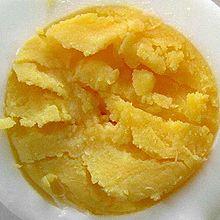

Boiled egg
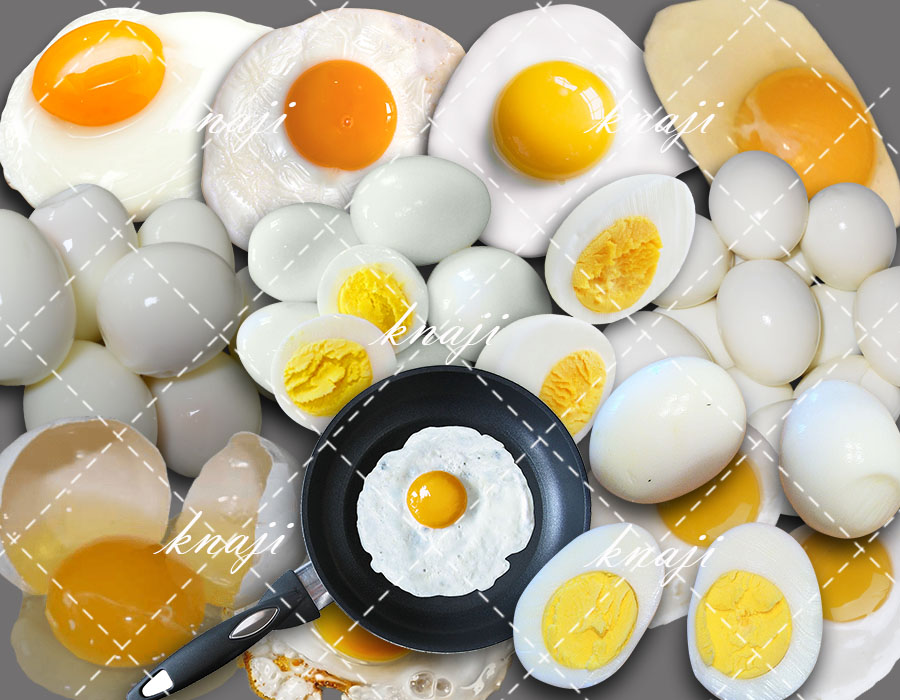
Jump to navigationJump to search

A soft-boiled egg served in the half shell
|
|||||||
| Main ingredients | Eggs (typically chicken) | ||||||
|---|---|---|---|---|---|---|---|
| Variations | Baked eggs, starting temperature, preparation | ||||||
| 136 kcal (569 kJ) | |||||||
|
|||||||
Boiled eggs are eggs, typically from a chicken, cooked with their shells unbroken, usually by immersion in boiling water. Hard-boiled eggs are cooked so that the egg white and egg yolk both solidify, while soft-boiled eggs may leave the yolk, and sometimes the white, at least partially liquid and raw. Boiled eggs are a popular breakfast food around the world.
Besides a boiling water immersion, there are a few different methods to make boiled eggs. Eggs can also be cooked below the boiling temperature, i.e. coddling, or they can be steamed. The egg timer was named for commonly being used to time the boiling of eggs.
Variations

Onsen tamago, a Japanese slow cook at a low temperature
There are variations both in degree of cooking and in the method of how eggs are boiled, and a variety of kitchen gadgets for eggs exist. These variations include:
- Serving temperature
- Room temperature (for more even cooking and to prevent cracking) or from a refrigerator; eggs may be left out overnight to come to room temperature.
- Piercing
- Some pierce the eggs beforehand with an egg piercer to prevent cracking. There is much debate on this subject. Ekelund[who?] et al. in Why eggs should not be pierced claimed that pricking caused egg white proteins to be damaged and was therefore to be discouraged. Others, including the American Egg Board, recommend against this, as it can introduce bacteria and create hairline cracks in the shell through which bacteria can enter the egg.[note 1]
- Vinegar
- Some add vinegar to the water (as is sometimes done with poached eggs) to prevent the white from billowing in case of cracking. For this purpose, table salt can also be used.
- Placing in water
- There are various ways to place the eggs in the boiling water and remove: one may place the eggs in the pan prior to heating, lower them in on a spoon, or use a specialized cradle to lower them in. A cradle is also advocated as reducing cracking, since the eggs do not then roll around loose. To remove, one may allow the water to cool, pour off the boiling water, or remove the cradle.
- Steaming
- Eggs can be taken straight from the refrigerator and placed in the steamer at full steam. The eggs will not crack due to sudden change in temperatures. At full steam, “soft-boiled” eggs can be ready in about 6 minutes and “hard-boiled” eggs in about twice that time. However due to variations in the starting temperature and the size of the egg as well as the altitude of the location (longer needed for higher altitudes), these times can only be an approximation.[1]
- Sous vide
- Rather than cooking in boiling water, boiled eggs can be made by cooking/coddling in their shell “sous vide” in hot water at steady temperatures anywhere from 60 to 85 °C (140 to 185 °F). It turns out that the outer egg white cooks at 75 °C (167 °F) and the yolk and the rest of the white sets from 60 to 65 °C (140 to 149 °F).[2][3]
- Cooking times
- There is substantial variation, with cooking time being the primary variable affecting doneness (soft-boiled vs. hard-boiled). It usually varies from 10–17 minutes for large hard-boiled eggs, 1–4 minutes for large soft-cooked eggs. Depending on altitude above sea level and humidity densities in a given climate, one may require extended amounts of time to reach the soft-boiled stage, and in fact, may never reach a fully hard stage.
- Cooking temperatures
- In addition to cooking at a rolling boil (at 100 °C (212 °F)), one may instead add the egg before a boil is reached, remove water from heat after a boil is reached, or attempt to maintain a temperature below boiling, the latter all variants of coddling.
- Cooling
- After eggs are removed from heat, some cooking continues to occur, particularly of the yolk, due to residual heat, a phenomenon called carry over cooking, also seen in roast meat. For this reason some allow eggs to cool in air or plunge them into cold water as the final stage of preparation. If time is limited, adding a few cubes of ice will quickly reduce the temperature for easy handling.
- Service
- Boiled eggs may be served loose, in an eggcup, in an indentation in a plate (particularly a presentation platter of deviled eggs), cut with a knife widthwise, cut lengthwise, cut with a knife or tapped open with a spoon at either end, or peeled (and optionally sliced, particularly if hard-boiled, either manually or with an egg slicer).
- Baked eggs
- Baking eggs in an oven instead of boiling in water. Baked eggs (350 °F (177 °C) for 1/2 hour in a muffin tin, cool in ice water) are identical to boiled eggs but the shells peel more easily.[citation needed]
Soft-boiled eggs
Chef Heston Blumenthal, after “relentless trials”, published a recipe for “the perfect boiled egg” suggesting cooking the egg in water that starts cold and covers the egg by no more than a millimeter, removing the pan from the heat as soon as the water starts to bubble. After six minutes, the egg will be ready.[4]
Soft-boiled eggs are not recommended for people who may be susceptible to salmonella, such as very young children, the elderly, and those with weakened immune systems.[5] To avoid the issue of salmonella, eggs can be pasteurised in shell at 57 °C for an hour and 15 minutes. The eggs can then be soft-boiled as normal.[6]
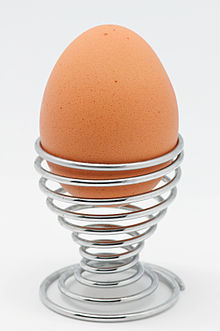
A boiled egg, presented in an egg cup
Soft-boiled eggs are commonly served in egg cups, where the top of the egg is cut off with a knife, spoon, spring-loaded egg topper, or egg scissors, using a teaspoon to scoop the egg out. Other methods include breaking the eggshell by tapping gently around the top of the shell with a spoon.[7] Soft-boiled eggs can be eaten with toast cut into strips, which are then dipped into the runny yolk. In the United Kingdom and Australia, these strips of toast are known as “soldiers“.[8]
In Southeast Asia, a variation of soft-boiled eggs known as half-boiled eggs are commonly eaten at breakfast. The major difference is that, instead of the egg being served in an egg cup, it is cracked into a bowl to which dark or light soy sauce or pepper are added. The egg is also cooked for a shorter period of time resulting in a runnier egg instead of the usual gelatin state and is commonly eaten with Kaya toast.
Boiled eggs are also an ingredient in various Philippine dishes, such as embutido, pancit, relleno, galantina, and many others.
In Japan, soft-boiled eggs are commonly served alongside ramen. The eggs are typically steeped in a mixture of soy sauce, mirin, and water after being boiled and peeled. This provides the egg a brownish color that would otherwise be absent from boiling and peeling the eggs alone. Once the eggs have finished steeping, they are served either in the soup or on the side.
Hard-boiled eggs
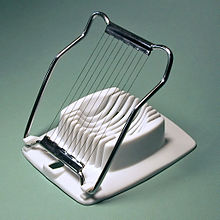
Egg slicers are used to slice hard-boiled eggs.
Hard-boiled eggs are boiled long enough for the yolk to solidify.[9] They can be eaten warm or cold. Hard-boiled eggs are the basis for many dishes, such as egg salad, cobb salad and Scotch eggs, and may be further prepared as deviled eggs.
There are several theories as to the proper technique of hard-boiling an egg. One method is to bring water to a boil and cook for ten minutes.[10] Another method is to bring the water to a boil, but then remove the pan from the heat and allow eggs to cook in the gradually cooling water.[9][11] Over-cooking eggs will typically result in a thin green iron(II) sulfide coating on the yolk.[12] This reaction occurs more rapidly in older eggs as the whites are more alkaline.[13] Immersing the egg in cold water after boiling is a common method of halting the cooking process to prevent this effect.[11] It also causes a slight shrinking of the contents of the egg.
Hard-boiled eggs should be used within two hours if kept at room temperature or can be used for a week if kept refrigerated and in the shell.[14][15][16][17]
Hard-boiled eggs are commonly sliced, particularly for use in sandwiches. For this purpose specialized egg slicers exist, to ease slicing and yield even slices. For consistent slice sizes in food service, several eggs may have their yolk and white separated and poured into a cylindrical mold for stepwise hard-boiling, to produce what is known as a “long egg” or an “egg loaf”. Commercial long eggs are produced in Denmark by its inventor Danæg and in Japan by KENKO Mayonnaise. The machine for producing long eggs was first introduced in 1974.[18] In addition to being sliced, long eggs can also be used in their entirety in gala pies.[19]
Peeling
Boiled eggs can vary widely in how easy it is to peel away the shells. In general, the fresher an egg before boiling, the more difficult it is to separate the shell cleanly from the egg white.[20] As a fresh egg ages, it gradually loses both moisture and carbon dioxide through pores in the shell; as a consequence, the contents of the egg shrink and the pH of the albumen becomes more basic. Albumen with higher pH (more basic) is less likely to stick to the egg shell, while pockets of air develop in eggs that have lost significant amounts of moisture, also making eggs easier to peel. Keeping the cooked eggs soaked in water helps keep the membrane under the egg shell moisturized for easy peeling. Peeling the egg under cold running water is an effective method of removing the shell. Starting the cooking in hot water also makes the egg easier to peel.[20] It is often claimed that steaming eggs in a pressure cooker makes them easier to peel.[21] However, double blind testing has failed to show any advantage of pressure cooking over steaming, and has further shown that starting boiling in cold water is counterproductive. Shocking the eggs by rapidly cooling them helped, and cooling them in ice water for 15 minutes or longer gave more successful peeling. Shocking was also found to remove the dimple in the base of the egg caused by the air space.[22]
Dishes featuring boiled eggs
Boiled eggs often form part of larger, more elaborate dishes. For example, a boiled egg may garnish a bowl of ramen (often first marinated in soy sauce), be baked into a pie such as a torta pasqualina,[23] or be encased in aspic (similar to the French dish œufs en gelée, which features poached eggs[24]), be chopped and mixed with mayonnaise to form egg salad, or be deep-fried and then baked within a serving of Lamprais.

An aspic with chicken and eggs
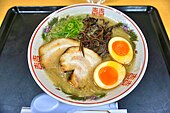
A bowl of ramen topped with a seasoned boiled egg. (Note the darkened exterior of the egg).
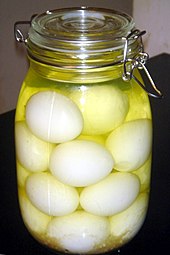
A jar of pickled boiled eggs.
See also
Notes
- ^ The American Egg Board, an industry group, recommends against piercing shells on food safety grounds: “Piercing shells before cooking is not recommended. If not sterile, the piercer or needle can introduce bacteria into the egg. Also, piercing creates hairline cracks in the shell through which bacteria can enter after cooking.”, Basic Hard-Cooked Eggs Archived January 2, 2010, at the Wayback Machine, American Egg Board
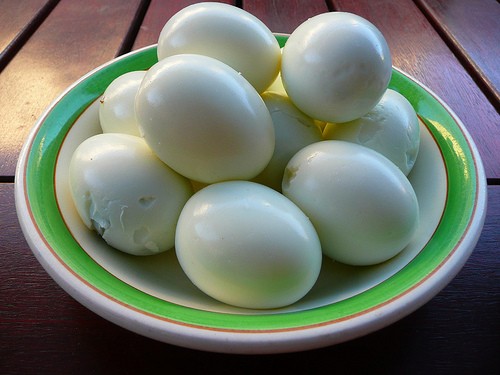

البيض المسلوق .. فوائد صحية يجهلها الكثيرون

هناك عدة فوائد صحية للبيض المسلوق وذلك لأنه يحتوي على الفيتامينات والمركبات الغنية، إذ يعتبر البيض المسلوق من أفضل وأسهل الوجبات الخفيفة، وأغناها بالفيتامينات والمعادن المهمة لصحة الجسم، وفقا لويب طب.
وبخصوص أهمية البيض فهو يعتبر غذاء متكاملاً تتجلى أهميته في تنوع مكوناته، إذا تحتوي بيضة مسلوقة واحدة على:
مجموعة من الفيتامينات المتنوعة مثل فيتامين (A)، فيتامين B5، فيتامين B12، فيتامين B2.
المعادن المختلفة مثل الكالسيوم والزنك والسيلينيوم، إضافة إلى الأوميجا 3.
أما بخصوص السعرات الحرارية تحتوي البيضة على 77 سعراً حرارياً، 6 غرامات من البروتين و5 غرامات من الدهون الصحية.
ونصح أحد الأطباء الاشخاص بتناول بيضة مسلوقة يوميا على الريق، وذلك للفوائد التالية:
1- يحسن صحة الدماغ
تناول البيض يؤدي إلى تحسين وظائف الدماغ بصورة جيدة، لأنه يحتوي على كمية كبيرة من مادة الكولين التي تعمل على تخفيف التهابات الدماغ، وخاصة الالتهابات التي لها علاقة بمرض الزهايمر.
كما يعد صفار البيض مصدراً غنياً بالأحماض الأمينية أوميجا 3 المفيد للجسم والدماغ.
2- يحافظ على صحة الجنين
يحتوي البيض المسلوق على نسبة عالية من عنصر الكالسيوم الضروري جداً للحفاظ على صحة وقوة العظام والمفاصل والأظافر والشعر لدى المرأة الحامل.
وكذلك هو غني جدًا بالبروتين الذي يعتبر أساسا لنمو كافة خلايا الجسم لدى الجنين مما يضمن له النمو الداخلي والخارجي السليم والمتكامل دون تشكل التشوهات الخلقية.
3- يمنع فقر الدم
فقر الدم هو نقص في خلايا الدم الحمراء أو الهيموجلوبين في الجسم، وإذا كان لديك عدد قليل جدا من خلايا الدم الحمراء أو الهيموجلوبين فإن خلايا الجسم لا تحصل على ما يكفي من الأوكسجين والغذاء.
4- يقوي العظام
البيض يحتوي على نسبة عالية من الكالسيوم والذي يلعب دوراً أساسيا في تكثيف أنسجة العظام ويقوي من تلاحمها، وبالتالي فهو يعالج مشكلة ترقق العظام وضعفها، مما يؤدي الى التقليل من نسبة تعرضها للكسر أو يقلل من حدة الصدمات على العظام.
لذلك فإن تناول البيض المسلوق يساعد بشكل قوي في بناء العظم داخلياً وتكوينه.
5- صحة الجلد
البيض المسلوق يحتوي على نسبة عالية من المواد المضادة للأكسدة وهذه المواد تعمل على معادلة الجذور الحرة بالجسم وبالتالي فهي تساعد على المحافظة على صحة الجلد والحصول على جلد صحي وبشرة نضرة وصحية.
6- يعمل على بناء العضلات
يعتبر البيض المسلوق من المصادر الجيدة للبروتينات، وهو من المأكولات المشبعة ذات قيمة غذائية عالية لما يوجد به من أحماض امينية متعددة، وايضا الحديد والفيتامينات التي تعمل على بناء عضلات الجسم بشكل سليم.
كما أن البيض غني بالسيلينيوم ومضادات الاكسدة التي تمنع تلف الأنسجة مما يحافظ على سلامة العضلات وقوتها.
7- يساعد في تنظيم الكوليسترول
يوفر البيض المسلوق نوعين من الدهون الجيدة والمعروفة بالدهون الأحادية غير المشبعة والدهون الجيدة المشبعة، لذلك فهو يساعد في خفض الكوليسترول السيء في الجسم والتقليل من خطر الإصابة بأمراض القلب.
8- يحسن من الرؤية
يحتوي بياض البيض على مادة اللوتين وهي مفيدة للغاية في منع الضمور البقعي والحد من خطر إعتام عدسة العين النامية.
كما أن الاثار المضادة للأكسدة له تساعد على تقوية شبكية العين وحماية العينين من أضرار الجذور الحرة والأشعة فوق البنفسجية للشمس.
9- مفيد لخسارة الوزن
أن تناول بيضة على الإفطار يساعد الأشخاص على الشعور بالامتلاء لفترات طويلة، ويقلل من مقدار الطعام الذي يتناولونه أثناء اليوم، الأمر الذي ينتج عنه انخفاض ملحوظ في كتلة الجسم ومحيط الخصر.
ــــــــــــــــــــــــــــــــــــــــــــــــــــــــــــــــــــــــ

البيض المسلوق
البيض المسلوق: يحظى البيض المسلوق بشهرة واسعة على مستوى العالم، فهو يحتوي على العديد من العناصر الغذائية الأساسية والضرورية لصحة أجهزة وأعضاء الجسم وتمكينها من أداء وظائفها الحيوية على أتم صورة ممكنة، أهمها؛ البروتين وفيتامين A وفيتامين. B2 وفيتامين B5 وفيتامين B9 والفسفور والسيلينيوم والكالسيوم والحديد وفيتامين E والمغنيسيوم والمنغنيز والصوديوم والزنك، كما أن البيض المسلوق يعد من الأطعمة ذات المحتوى المعتدل من السعرات الحرارية، فالواحدة منه تزود بما يقارب 77.5 سعرة حرارية، يقدم البيض المسلوق عددًا كبيرًا من الفوائد الصحية، وفيما يأتي توضيح لأهم فوائد البيض المسلوق.[١]
فوائد البيض المسلوق:
تتعدد فوائد البيض المسلوق وتتنوع، ويعود ذلك إلى كونه واحدًا من الأطعمة ذات القيمة الغذائية العالية، فهو يعد مصدرًا غنيًا بالبروتين والدهون الصحية والكولين والعديد من مضادات الأكسدة، وفيما يأتي توضيح وحديث مسهب عن فوائد البيض المسلوق.[٢]
مصدر غني بالدهون الصحية:
تقسم الدهون اعتمادًا على تأثيرها على صحة جسم الإنسان إلى مجموعتين؛ دهون صحية تتضمن الدهون غير المشبعة بنوعيها؛ الأحادية والمتعددة، ودهون ضارة تتضمن كلًا من الدهون المتحولة والدهون المشبعة، ويعد البيض المسلوق مصدرًا من مصادر الدهون الصحية، إن لم يكن أفضلها على الإطلاق، ومن الجدير بالذكر أن استبدال مصادر الدهون غير الصحية بمصادر الدهون الصحية قدر المستطاع يخفِّض مستويات الكولسترول في الدم ويقلل خطر الإصابة بأمراض القلب والشرايين وينظم مستويات الجلوكوز في الدم ويحافظ على ضمان معدلاتها الطبيعية لدى المصابين بمرض السكري.[٣]
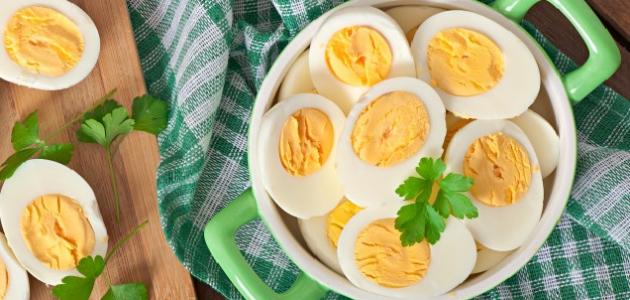
المحافظة على صحة العظام:
إن أهم فائدة من فوائد البيض المسلوق تتمثل في قدرته على المحافظة على صحة وقوة العظام، ويعزى ذلك إلى كونه مصدرًا غنيًا بفيتامين D الذي يعرف بدوره الضروري والحرج في امتصاص الكالسيوم وتنظيم مستوياته في مجرى الدم، الأمر الذي يضمن إمداد الهيكل العظمي بحاجته من عنصر الكالسيوم، تحتوي البيضة المسلوقة ذات الحجم الكبير على ما يعادل 45 وحدة دولية من فيتامين D، أما حاجة الجسم اليومية منه فتبلغ 600 وحدة دولية.
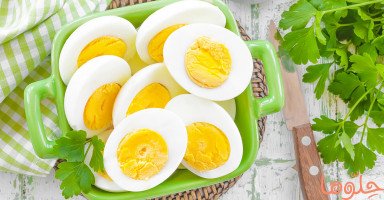 المحافظة على صحة العين:
المحافظة على صحة العين:
تتمثل الفائدة العظمى من فوائد البيض المسلوق في قدرته على المحافظة على صحة العين ووقايتها من بعض الأمراض والمشكلات الشائعة والمتعلقة بالتقدم بالعمر، ويعزى ذلك إلى احتوائه على اثنين من مضادات الأكسدة المعروفة بدورها في مكافحة الحذور الحرة ومنع تراكمها في منطقة العين، وهما؛ اللوتين Lutein والزيازانثين Zeaxanthin، كما أن هذين المركبين يساهمان في تقليل خطر تكون المياه البيضاء والزرقاء في العين، ويقيان من مرض التنكس البقعي المرتبط بتقدم العمر.[٢]

المحافظة على صحة الدماغ:
يحتوي البيض المسلوق، أو بالأحرى صفار البيض، على مستويات عالية جدًا من الكولين Choline، وهو مركب غذائي أساسي للعديد من وظائف الجسم الحيوية؛ يمثل المادة الخام لناقل عصبي يدعى أسيتيل كولين Acetylcholine المسؤول عن مهارتي التعلم والذاكرة في الدماغ، ويعزز نمو دماغ الجنين ويطور مهارات الذاكرة لديه ويقيه من التشوهات الخلقية المتعلقة بالدماغ والنخاع الشوكي، ويدعم وظائف الدماغ الإدراكية والمعرفية لدى كبار السن، وعلى الرغم من إمكانية إنتاج الكولين في الجسم، إلا أن ذلك يكون بمستويات قليلة جدًا لا ترقى لتلبية احتياجات الجسم اليومية منه، لذلك يجب الحصول عليه من مصادره الغذائية، ومنها البيض، إذ تزود البيضة الواحدة بما مقداره 147 مليغرام من الكولين، أي ما يعادل 27% من إجمالي احتياجات الجسم اليومية منه

| بيض مسلوق | |
|---|---|
|
بيضة نصف مسلوقة (بيضة برشت)
|
|
|
|
|
| النوع | غذاء، وطبق |
| المكونات الرئيسية | بيض |
| السعرات الحرارية | 136 سعرة (569 كيلوجول) |
|
|
|
| القيمة الغذائية | |
| البروتينات | 14 غرام |
| الدهون | 9 غرام |
البيض المسلوق هو البيض (غالباً بيض الدجاج) المطهُوّ دون كسر قشرته الخارجية من خلال وضعه في الماء المغلية.[1][2] والبيض المسلوق تماماً هو الذي تم طهيه حتى أصبح قوام كل من بياضه ومحه متماسكاً وصلباً، أما البيض نصف المسلوق أو بيض البرشت فيبقى قوام محه سائلاً وبياضه يحافظ على بعض اللزوجة إلى حد ما.
تركيبته:
بياض (الاح)، الصفار (المح)، وغرفة الهواء التي تقع في أحد قطبي البيضة، والقشرة التي تحمي البيضة من المؤثرات الخارجية.
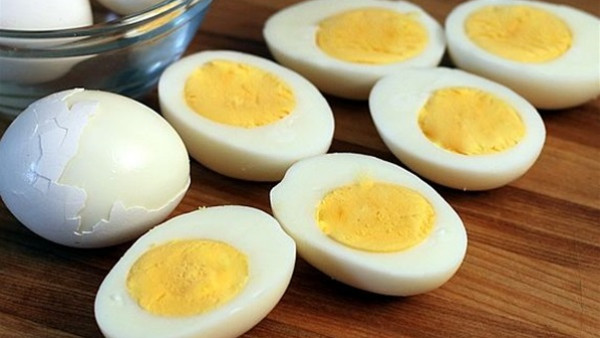
- البياض: وهو الذي يعمل على تغذية الجنين الذي يبدأ نموه في منطقة الصفار، ويكون البياض غذاء مخزن للجنين، يعطيه الغذاء والطاقة للنمو قبل التفقيس، وهو مادة دهنية غليظة تحتوي على:• ليفيتين • ليستين • فيتالين • كوليسترول • حديد • فوسفور
- الصفار: يحتوي على مواد حيوية مثل الحديد والفوسفور، وكذلك بعض الفيتامينات (مثل: أ، ب، ج، د، هـ). وتطفو على سطح الصفار حويصلة النطفة، وهي تتميز ببياضها، من هذه النقطة، يبدأ تكوّن الجنين ونموه داخل البيضة.
- غرفة الهواء: تقع في الجزء الأكبر من البيضة، وتكون ضيقة لا تكاد تُرى في البيضة الطازجة، وكلما تبخر الماء من سوائل البيضة مع الوقت، إلا وازداد حجم غرفة الهواء، لذلك يمكن معرفة البيض الطازج بوضعه بالماء مع إذابة القليل من الملح بالماء، فإذا لم تطفو البيضة على السطح فهذا يدل على أن غرفة الهواء ضيقة وصغيرة، أي أن البيضة طازجة، فهذه التجربة أثبتت أن البيض طازج إذا كان عمره أقل من عشرة أيام، وإن طفت البيضة فإن عمرها ما بين عشرة أيام وعشرين يوماً.
- القشرة الخارجية: وهي مركبة أساسا من الكالسيوم، وبمراقبتها بالمجهر نشاهد مسامات كثيرة مغطاة بمادة رقيقة، تمنع دخول الجراثيم و الهواء إلى داخل البيضة، ولكنها لا تمنع تبخر الماء من داخل البيضة وخروجه إلى الخارج، وكثرة لمس البيضة بالأيدي أو الغسل يُفسد هذا التركيب الرقيق المصمم للتهوئة، مما يؤدي إلى تلوث البيضة وفسادها.
تناوله
إن البيض غني بالبروتين، و غني بالحديد، وهو أغنى من الحليب بالحديد، والحليب أغنى بالكالسيوم من البيض، والبيض والحليب غنيان بفيتامين د، وكذلك فإن البيض غني بالأملاح المعدنية وفقير من النشويات، مما يجعله مع لائحة الأغذية المستعملة في تخفيض الوزن.
أفضل الطرق لتناول البيض هو البيض غير المكتمل السلق، أي (البرشت)، وهو الأسهل هضماً، والبيض المسلوق أسهل هضماً من البيض المقلي.
يمنع الإكثار من البيض في بعض الحالات
قد يمتنع عن الإكثار من البيض في الحالات التالية:
- المصابون بكسل في وظيفة الكبد، وحصى المرارة.
- المصابون بالتحسس من أكل البيض.
- المصابون بارتفاع حاد بالكوليسترول (دهن الدم).
- المصابون بالربو وحساسية الصدر.
- المصابون بنشاف شرايين القلب، أو الدماغ.
- المصابون بالتهابات الكلى، والحصى والرمل.








